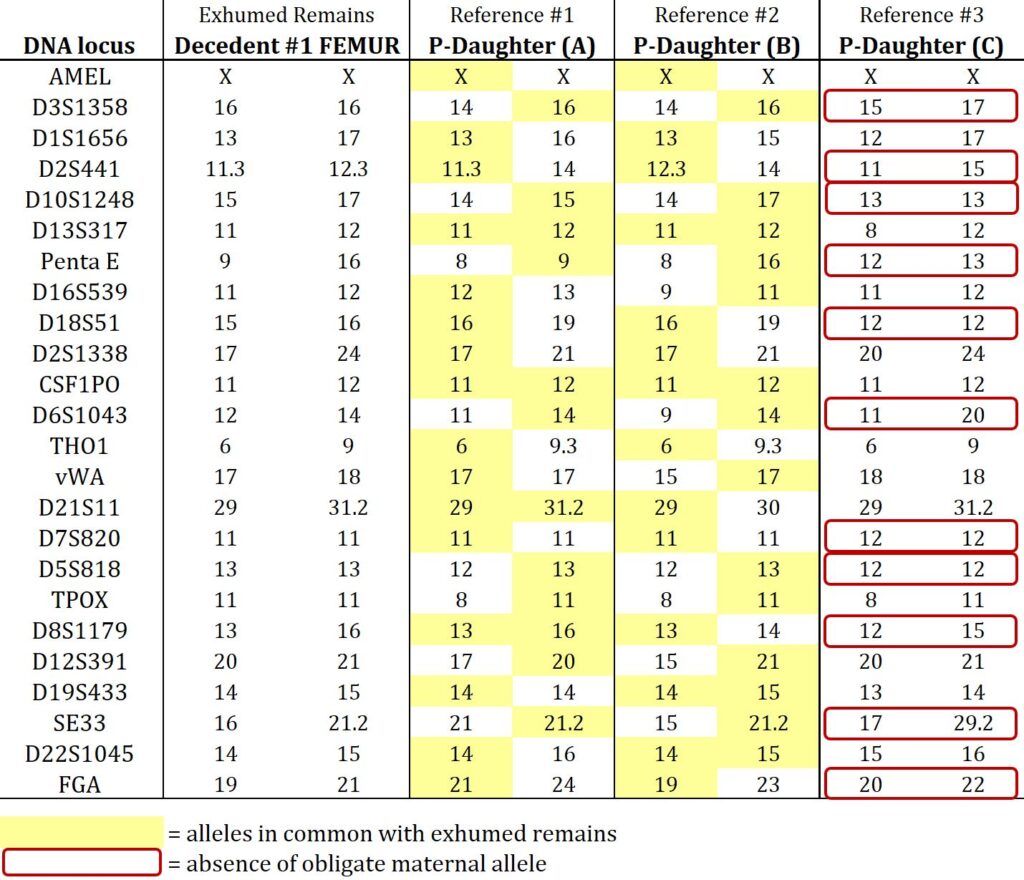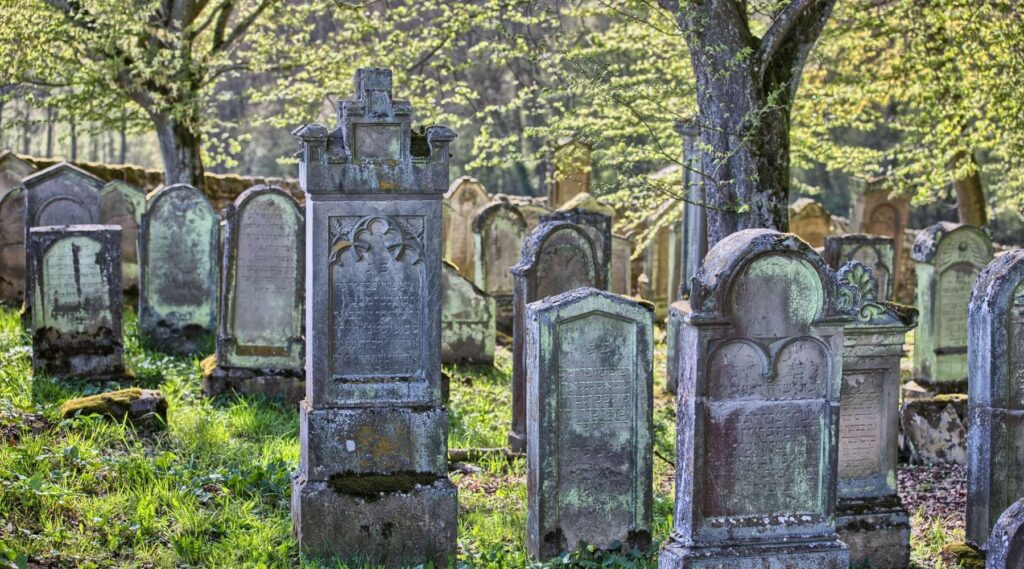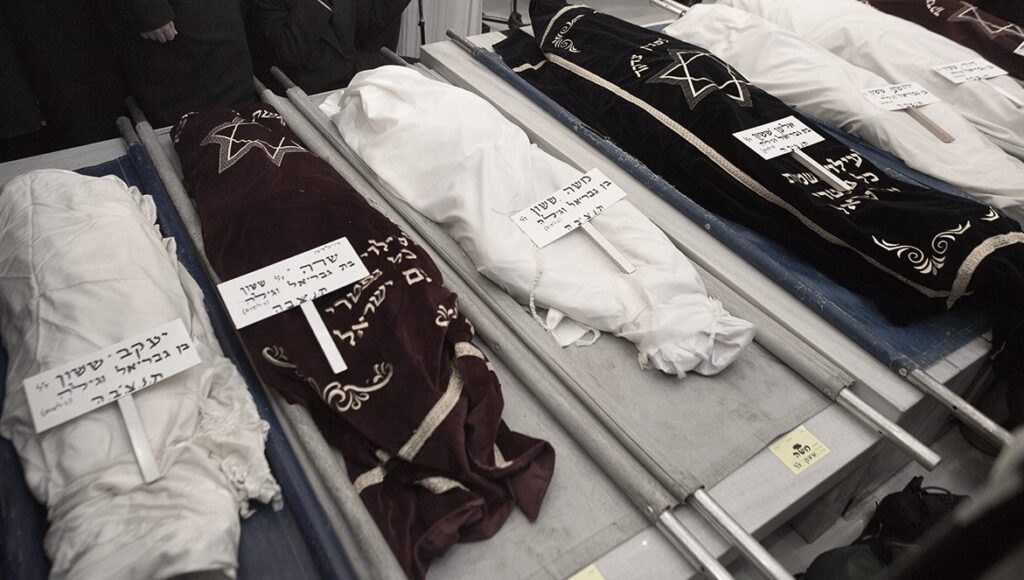Today’s blog is written by Angie Ambers, Ph.D., Assistant Director at Henry C. Lee Institute of Forensic Science. Read the full version in the November 2020 issue of The ISHI Report.
In October 2019, two adult female decedents were processed by the same funeral home in Guilford, Connecticut. According to traditional Jewish funeral practices, the bodies of both women were prepared for burial according to tahara (ritual purification, no embalming) by a chevra kadisha (sacred burial society), wrapped completely head-to-toe in a tachrichim (simple white shroud), and interred in a simple wooden casket (aron).
Decedent #1 was emaciated at the time of death due to a long illness; Decedent #2 was reportedly obese. Pallbearers at the funeral of Decedent #1 remarked that her casket seemed exceedingly heavy based on her low body weight at the time of death.
A few months later, family members of Decedent #1 visited her gravesite, noticed that the date-of-birth on her headstone was incorrect, and suspected that there may have been an accidental “burial switch” at the cemetery. Consequently, the families of both women convened and petitioned the funeral home to exhume Decedent #1 to investigate the matter.
In June 2020, human remains were exhumed for DNA testing to confirm the identity of the woman interred in Decedent #1’s burial plot. A small section from the diaphysis of the exhumed decedent’s right femur was collected for DNA testing, along with family reference samples (buccal swabs) from two of Decedent #1’s biological daughters and the sole biological daughter of Decedent #2.
Traditional forensic DNA casework approaches for human skeletal remains are time-consuming and labor-intensive, often taking weeks-to-months to obtain genetic testing results. Rapid DNA technology offers the capability to provide a more timely resolution (< 2 hours processing time) and closure to families on such sensitive issues. Bone samples collected during the exhumation and buccal swab (family) exemplars were processed on the ANDE® 6C Rapid DNA System (ANDE® Corporation, Waltham, Massachusetts USA) using the FlexPlex® 27 assay (which incorporates the 20 core CODIS loci mandated by the FBI for casework) and the patented I-Chip™ and A-Chip™ (for bone samples and reference swabs, respectively). Kinship analysis was performed using the Claimed Relationships module of ANDE® FAIRS™ software (ANDE® Corporation).
Introduction
The death of a loved one is a tragedy that is difficult to accept and overcome. When a funeral home or cemetery personnel are suspected of mishandling the burial or gravesite of a deceased person (due to negligence or malfeasance), the family’s heartache and grief are even further amplified. Although formal investigations of alleged “burial switches” via exhumation and DNA testing can provide definitive resolution, traditional (standard) forensic DNA casework methods for decomposed or skeletonized human remains are labor-intensive and time-consuming (which can prolong the family’s anguish and delay closure). Rapid DNA testing platforms offer the potential for a reliable, quick resolution to investigations involving an allegation of mistaken burial in the wrong cemetery plot.
In this case, two adult female decedents were processed by the same funeral home on the same day in October 2019. Decedent #1 was scheduled to be interred at a cemetery in Guilford, Connecticut; the other adult female (Decedent #2) was to be transported to New Jersey for burial. The bodies of both women were prepared according to traditional Jewish burial customs — i.e., with tahara (ritual purification, no embalming) by a chevra kadisha (sacred burial society), wrapped completely head-to-toe in a tachrichim (simple white shroud), and with ‘funeral stones’ (typically shards of earthenware clay pottery) placed over their eyes. After being wrapped (head-to-toe) in the shroud, the deceased is placed in a simple wooden casket (aron) and there is no “viewing” prior to burial. Decedent #1 barely weighed 100 lbs at the time of her death due to a prolonged battle with cancer; Decedent #2 was reportedly obese. The pallbearers at Decedent #1’s funeral (all of whom were strong males in their mid-20s) commented that the casket seemed excessively heavy, especially given the emaciated state of the decedent at the time of her death (but the family was too grief-stricken at the time to consider any potential mistakes or to inquire with the funeral director). A few months later, upon visiting Decedent #1’s gravesite, the family noticed that the date-of-birth (DOB) on her headstone was incorrect. With some additional investigation, it was discovered that the DOB etched into the headstone above Decedent #1’s burial plot was actually the DOB of Decedent #2. The families of both Decedent #1 and Decedent #2 worked together to request a formal inquisition into the matter, to investigate if the burials were accidentally switched.
Materials and Methods
In June 2020, the remains of an adult female (Decedent #1) interred at a cemetery in Guilford, Connecticut were exhumed for the purpose of DNA testing. The total burial period at the time of exhumation was approximately 9 months. Post-exhumation, height measurements were taken, the tachrichim (white shroud) was unwrapped, and the traditional placement of ‘funeral stones’ (clay pot remnants) atop the eyes of the decedent was confirmed. A portion of the diaphysis of the decedent’s right femur was removed using an oscillating Mopec® 1000 Autopsy Saw and sterile sectioning blade (Mopec, Madison Heights, Michigan USA); the femur section was stored in a sterile 50-ml polypropylene conical tube for storage and transport. Adhered (decomposed) soft tissue was removed from the femur section using a sterile scalpel. The bone was then surface-cleaned via submersion in 10% sodium hypochlorite (NaOCl) with vigorous shaking for 30 seconds, thorough rinsing with molecular grade water, and brief immersion in absolute ethanol (EtOH). After drying overnight (at ambient temperature) in a dead-air hood, the femur section was pulverized using a pre-sterilized hammer and steel mortar-and-pestle; 0.5g of pulverized femur was immersed in ANDE™ Bone Solution (proprietary) with Proteinase K (20 mg/mL); and the sample was incubated overnight to demineralize the bone matrix and facilitate DNA release.
For comparison, familial reference samples (buccal swabbings using sterile cotton swabs) were collected from the following individuals: 1) the two biological daughters of Decedent #1; and 2) the sole biological daughter of Decedent #2. These exemplars were processed separately from the femur samples collected during the exhumation of Decedent #1. All samples were processed on the ANDE® 6C Rapid DNA System (ANDE® Corporation, Waltham, Massachusetts USA) using the FlexPlex® 27 assay (which incorporates the 20 core CODIS loci mandated by the FBI for casework) and the patented I-Chip™ and A-Chip™ (for bone samples and reference swabs, respectively). Kinship analysis was performed using the Claimed Relationships module of ANDE® FAIRS™ software (ANDE® Corporation).
Results and Conclusions
Complete (full) DNA profiles were obtained from the exhumed remains (femur), from the buccal swabs of Decedent #1’s two biological daughters (A-B), and from the sole biological daughter (C) of Decedent #2 (Table 1).

Using the genetic typing results shown in Table 1 and the Claimed Relationships module of ANDE® FAIRS™ software (ANDE® Corporation), match statistics were calculated and the following conclusions were drawn:
- The exhumed remains (Decedent #1) cannot be excluded as being the biological mother of the reference sample donated by putative Biological Daughter (A). The Combined Maternity Index is 719,842,881. The relative chance of Maternity is 99.99999986% as compared to an untested, unrelated woman in the NIST general population.
- The exhumed remains (Decedent #1) cannot be excluded as being the biological mother of the reference sample donated by putative Biological Daughter (B). The Combined Maternity Index (CMI) is 8,214,305,007. The relative chance of Maternity is 99.99999999% as compared to an untested, unrelated woman in the NIST general population.
- The exhumed remains (Decedent #1) are excluded as being the biological mother of the reference sample donated by the putative Biological Daughter (C), due to the absence of an obligate maternal allele at the following tested loci: D3S1358, D2S441, D10S1248, Penta E, D18S51, D6S1043, D7S820, D5S818, D8S1179, SE33, and FGA (see Table 1).
This case study demonstrates proof-of-concept that the ANDE® 6C Rapid DNA System can be effectively used to generate DNA profiles from exhumed human remains in alleged “mistaken burial” cemetery investigations. In this case, the remains of two adult females processed by the same funeral home on the same day were actually interred in the correct burial plots; however, the DOB information on their headstones was transposed. The postmortem interval (PMI) for the exhumed remains in this case was approximately 9 months. Future studies should explore PMI limits for this technology, as well investigate buried remains from a broad range of burial environments (e.g., different climates, varied soil pH ranges).
Acknowledgements
The author would like to express sincere gratitude to Dr. Richard Selden, Dr. Rosemary Turingan, and Dr. Eugene Tan of ANDE® Corporation for their expertise, compassion, and generosity in donating reagents and time to assist the Henry C. Lee Institute in resolving this case. We also thank the family of both decedents for entrusting our team with the handling and processing of their loved ones’ remains in order to provide closure on such a sensitive issue. The surnames of both decedents in question are withheld out of respect and to protect the families’ privacy.
References
- Turingan RS, Tan E, Jiang H, Brown J, Estari Y, Krautz-Peterson G, Selden RF (2020). Developmental validation of the ANDE® 6C System for Rapid DNA analysis of forensic casework and DVI samples. Journal of Forensic Science, doi: 10.1111/1556-4029.14286.
- S. Department of Defense (DoD) (MIL-STD-810G, October 2008). Department of Defense test method standard: Environmental engineering considerations and laboratory tests. https://www.atec.army.mil/publications/Mil-Std-810G/Mil-Std-810G.pdf
- Carney C, Whitney S, Vaidyanathan J, Persick R, Noel F, Vallone PM, Romsos EL, Tan E, Grover R, Turingan RS, French JL, Selden RF (2019). Developmental validation of the ANDE® Rapid DNA system with Flex-Plex™ assay for arrestee and reference buccal swab processing and database searching. Forensic Science International Genetics (40), 120-130.
- gov (2017). H.R.510 – Rapid DNA Act of 2017. https://www.congress.gov/bill/115th-congress/house-bill/510.
- Miroff N (2019). Homeland Security to test DNA of families at border in cases of suspected fraud. The Washington Post, https://www.washingtonpost.com/immigration/homeland-security-to-test-dna-of-families-at-border-in-cases-of-suspected-fraud/2019/05/01/8e8c042a-6c46-11e9-a66d-a82d3f3d96d5_story.html?utm_term=.b4611915101f.
- Gin K, Tovar J, Bartelink EJ, Kendell A, Milligan C, Willey P, Wood J, Tan E, Turingan RS, Selden RF (2020). The 2018 California Wildfires: Integration of Rapid DNA to dramatically accelerate victim identification. Journal of Forensic Science https://doi.org/10.1111/1556-4029.14284.
- Department of Homeland Security (2019). Snapshot: S&T’s Rapid DNA technology identified victims of California Wildfire, DHS Science and Technology News, https://www.dhs.gov/science-and-technology/news/2019/04/23/snapshot-st-rapid-dna-technology-identified-victims.
- Border G (2018). California taps war-zone DNA specialists after wildfire. Reuters, https://www.reuters.com/article/us-california-wildfires-remains/california-taps-war-zone-dna-specialists-after-wildfire-idUSKCN1NK1EI.
- Brown KV (2018). California turns to war-zone DNA test to ID fire remains. Bloomberg, https://www.bloomberg.com/news/articles/2018-11-19/dna-testing-company-gets-call-to-help-id-california-fire-victims.
- Druga M (2019). Rapid DNA technology identified victims of California wildfires. Homeland Preparedness News, https://homelandprepnews.com/stories/33583-rapid-dna-technology-identified-victims-of-california-wildfires/.
- Gin K (2019). California Wildfires: Rapid DNA and the future of mass fatality identification. Forensic Science Executive, www.forensicscienceexecutive.org.
- Sernoffsky E (2018). DNA technology helps identify Camp Fire victims; challenge is finding family. San Francisco Chronicle, https://www.sfchronicle.com/california-wildfires/article/DNA-technology-helps-identify-Camp-Fire-victims-13406853.php.
- Waitt T (2019). Rapid DNA ID’s deadly ‘Camp Fire’ disaster victims. American Security Today, https://americansecuritytoday.com/rapid-dna-ids-deadly-camp-fire-disaster-victims-see-how-video/.
- Zimmer K (2018). Rapid DNA analysis steps in to identify remains of wildfire victims. The Scientist, https://www.the-scientist.com/news-opinion/rapid-dna-analysis-steps-in-to-identify-remains-of-wildfire-victims-65156.
- Department of Homeland Security (2019). Snapshot: Rapid DNA identifies Conception boat fire victims, DHS Science and Technology News, https://www.dhs.gov/science-and-technology/news/2019/12/10/snapshot-rapid-dna-identifies-conception-boat-fire-victims#.
- Woods A (2019). Officials used “Rapid DNA” tech to identify California boat fire victims. The New York Post, https://nypost.com/2019/09/05/officials-used-rapid-dna-tech-to-identify-california-boat-fire-victims/.
- Turingan RS, Brown J, Kaplun L, Smith J, Watson J, Boyd DA, Steadman DW, Selden RF (2019). Identification of human remains using Rapid DNA analysis. International Journal of Legal Medicine, https://doi.org/10.1007/s00414-019-02186-y.
- Turingan RS, Tan E, Jiang H, Brown J, Estari Y, Krautz-Peterson G, Selden RF (2020). Developmental validation of the ANDE® 6C System for Rapid DNA Analysis of forensic casework and DVI samples. Journal of Forensic Science 65 (4), 1056-1071.
WOULD YOU LIKE TO SEE MORE ARTICLES LIKE THIS? SUBSCRIBE TO THE ISHI BLOG BELOW!
SUBSCRIBE NOW!




